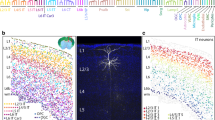Abstract
Evoked potentials to stimulation of the ventrolateral and intralaminar thalamic nuclei, the surface of the sensomotor cortex, and the pyramidal pathways, derived from the same point, and also corresponding postsynaptic responses of pyramidal neurons were studied in acute experiments on cats anesthetized with ether or superficially with pentobarbital (25–30 mg/kg, intraperitoneally), and immobilized with muscle relaxants. Surface application of strychnine inhibits the slow negative potential arising in response to direct and primary responses, and the corresponding slow potentials of the IPSP. The action of iontophoretic application of strychnine on IPSP of pyramidal neurons and responses of cortical glial cells also were studied. Both methods of application of strychnine block mainly the early component of the IPSP, during which the input resistance is significantly lower than that during the late component, evidence of their different genesis. The results of the investigation show that slow negative potentials are a reflection of hyperpolarization of pyramidal neurons, and that the separate components of the responses have a common genesis.
Similar content being viewed by others
Literature cited
L. L. Voronin, “Facilitation of responses of cortical neurons to cortical and peripheral stimulation after tetanization of the brain surface,” Neirofiziologiya,3, 1, 3 (1971).
T. Sh. Labakhua, G. L. Bekaya, and V. M. Okudzhava, “Analysis of prolonged cortical evoked potentials,” Neirofiziologiya,14, 2 115 (1982).
A. Mzhaviya, “The study of inhibition of cerebral cortical neurons and particular features of this electrocorticographic manifestation in the normal brain and epileptic foci,” Author's Abstract of Candidate's Dissertation, Tbilisi (1982).
V. M. Okudzhava, “The role of inhibition processes in epilietic activity,” in: Neurophysiological Mechanisms of Epilepsy [in Russian], Metsniereba, Tbilisi (1980), pp. 51–59.
A. I. Roitbak, “On the origin of negative shifts of cortical surface potential,” in: the Functional Role of Electrical Processes of the Brain [in Russian], Nauka, Moscow (1977), pp. 357–367.
V. M. Storozhuk, “Unit activity in the primary somatosensory cortical projection area during the primary response,” Zh. Vyssh. Nerv. Deyat.,18, 4, 681 (1968).
J. C. Eccles, The Physiology of Synapses, Springer-Verlag, Berlin (1964).
T. J. Biscoe and D. R. Curtis, “Strychnine and cortical inhibition,” Nature,214, 914 (1967).
R. S. Burke, K. M. Nelson, R. A. Naumann, and O. M. Young, “Studies of the production and subsequent reduction of swelling in the primate cerebral cortex under isosmotic conditionsin vivo,” Exp. Brain Res.,10, 4 427 (1970).
V. F. Castelluchi and S. Goldring, “Contribution to steady potential shifts of slow depolarization in cells presumed to be glia,” Electroenceph. Clin. Neurophysiol.,28, 2, 109 (1979).
S. Goldring and J. L. O'Leary, “Cortical dc changes incident to midline thalamic depolarization of cortical glial cells,” Brain Res.,14, No. 2, 401 (1969).
L. Hertz, “Neuroglial localization of potassium and sodium effects on respiration in brain,” J. Neurochem.,13, No. 12, 1371 (1966).
K. Krnjević, M. Ravdić, and D. W. Straughan, “Nature of a cortical inhibitory process,” J. Physiol. (London),184, No. 1, 49 (1966).
G. Levi, G. Bernardi, E. Cherubini, V. Gillo, M. G. Marciani, and P. Stanzione, “Evidence in favor of a neurotransmitter role of glycine in the rat cerebral cortex,” Brain Res.,236, No. 1, 121 (1982).
H. Matsumoto and C. Ajmone-Marsan, “Cortical cellular phenomena in experimental epilepsy: interictal manifestations,” Exp. Nuerol.,9, 286 (1964).
S. Ochs, “Analysis of cellular mechanisms of direct cortical responses,” Fed. Proc.,21, No. 3, 642 (1962).
D. A. Pollen, K. H. Reid, and P. Perot, “Microelectrode studies of experimental 3/sec wave and spike in the cat,” Electroenceph. Clin. Neurophysiol.,17, No. 2, 57 (1964).
D. A. Pollen and P. G. Sie, “Analysis of thalamic induced wave and spike by modifications in cortical excitability,” Electroenceph. Clin. Neurophysiol.,17, No. 2, 154 (1964).
B. R. Ransom and S. Goldring, “Slow depolarization in cells presumed to be glia in cerebral cortex of cat,” J. Neurophysiol.,36, No. 5, 869 (1973).
C. Stefanis, “Interneuronal mechanisms in the cortex,” in: The Interneuron, M. A. Brazier, ed., Univ. of Calfornia Press, Los Angeles (1969), pp. 497–526.
C. Stefanis and H. Jasper, “Recurrent collateral inhibition in pyramidal tract neurons,” J. Neurophysiol.,27, No. 5, 855 (1964).
M. Takata and K. Ogata, “Two components of inhibitory postsynaptic potentials evoked in hypoglossal motoneurons by lingual nerve stimulation,” Exp. Neurol.,60, No. 2, 299 (1980).
Author information
Authors and Affiliations
Additional information
Translated from Fiziologicheskii Zhurnal SSSR imeni I. M. Sechenova, Vol. 70, No. 8, pp. 1132–1141, August, 1984.
Rights and permissions
About this article
Cite this article
Okudzhava, V.M., Bekaya, G.L., Labakhua, T.S. et al. Prolonged negative surface potentials of the cat sensomotor cortex and responses of neurons and glial cells. Neurosci Behav Physiol 16, 417–426 (1986). https://doi.org/10.1007/BF01185373
Received:
Issue Date:
DOI: https://doi.org/10.1007/BF01185373




